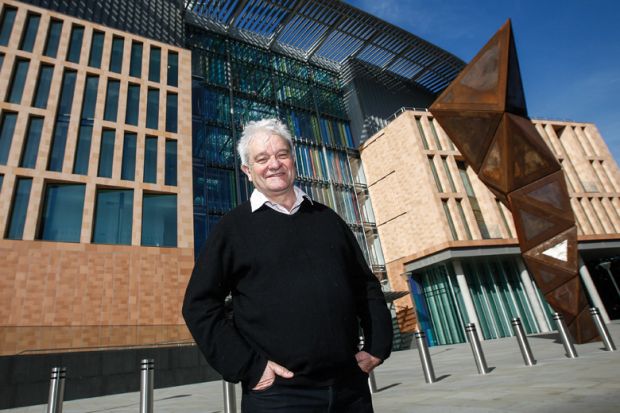“This is the messiest part of the building,” boasts Sir Paul Nurse, looking towards the rows of lab benches where his young research team’s plastic containers and specimen dishes are starting to mount.
It has been only two weeks since the Nobel laureate moved into his modest corner office at the Francis Crick Institute, but Sir Paul’s team have clearly settled into their new surroundings.
With Sir Paul, the Crick’s director and chief executive, among the many researchers padding round the £650 million building in trainers, it is also clear that many scientists feel at home in the informal, relaxed atmosphere of Europe’s largest biomedical research institute, which officially opened on 1 September.
Indeed, one of the Crick’s research group leaders – Nick Luscombe, professor of computational biology at University College London – wore pedal pushers and bright yellow socks as he talked to journalists about his work on genomics at the institute’s launch.
It is one of the many signs that the Crick is doing things differently, particularly with its emphasis on encouraging “neighbours” from different research groups to interact.
“It’s been said the Crick is a place where you can run but you can’t hide,” explains research director Sir Richard Treisman on how architects have designed sociability into the 170m-long building next to St Pancras International railway station.
“There are very few floors – just three full floors – with many half-floors, so it ensures people come out [of their labs] and meet each other,” Sir Richard adds.
To that end, the institute is filled with break areas and informal collaboration spaces, with closed-off meeting rooms kept to a minimum. Research groups from different disciplines are housed next to each other in “neighbourhoods” to get scientists talking to each other.
“The building is designed to break down barriers – having a bit of gentle anarchy is good,” explains Sir Paul.
Having the range of biomedical disciplines, experiments and expertise under the same roof also makes the Crick “quite unique”, adds associate research director Anne O’Garra, whose immunology research focuses on tuberculosis.
“I have worked in the US and all over the world and they do not have anything like this,” says O’Garra.
“We have experimental models going on everything from yeast, fruit flies and zebrafish, on mice and men,” she adds.
With the chic Walter Knoll chairs still in their delivery boxes, the institute is not completely ready, but Sir Paul firmly believes that the Crick will soon become an “international beacon for UK science so we can attract the best scientists from around the world”.
That has been made slightly harder by June’s Brexit poll result, he admits. Around 55 per cent of the Crick’s researchers are non-UK nationals from the European Union, so obtaining work permits for these individuals – if that is ever required post-Brexit – will entail “more bureaucracy and more costs”, Sir Paul said.
“The £5 million a year [we get] from the European Union is also at risk – we planned to increase it to £10 million – so we need to persuade the government to replace that funding lost from the EU,” he adds.
Nonetheless, Sir Paul is confident that the Crick, whose annual budget of about £130 million comes mostly from the Medical Research Council, Cancer Research UK and the Wellcome Trust, will lead the world in research into how to prevent, diagnose and treat a range of debilitating medical conditions.
“Through understanding how cells work more effectively we will generate knowledge that will address many conditions, particularly cancer.
“Learning about signalling in cells will be important for work on strokes and how nervous systems work,” he adds.
However, the Crick will also become a “pipeline for great researchers we have recruited from around the world” into universities and research institutes across the UK, Sir Paul adds.
“We will not hang on to the best researchers – we will train them and then push them out,” he says.
“After a period of around 12 years we will help them go anywhere in the country where they will prosper,” he adds.
That promise may partially address concerns that the Crick represents yet another example of London-centric science funding at the expense of clusters of excellence outside the “golden triangle” of Oxbridge and London.
However, with Imperial College London, University College London and King’s College London each chipping in £40 million to the Crick’s cost, as well as moving many of their research teams there, the charge is unjustified, says Sir Paul.
“This is a merger of three London institutions, so to move somewhere else would have caused huge upheaval [to researchers],” he says.
Next month, a call for outstanding early career researchers will go out, with all staff moving into the Crick by the start of 2017 – the latest stage of a project that was still just an idea in 2007.
With Sir Paul’s cherished office plants now installed on his desk (one is more than 30 years old), the task of creating a world-class research powerhouse looks as though it is beginning to take root.
后记
Print headline: ‘Gentle anarchy’ will fire Crick Institute’s research




